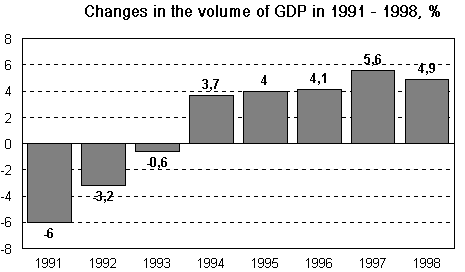26 February, 1999
Inquiries: National Accounts, Mr Tuomas
Rothovius +358 9 1734 3360, Mr Olli Savela +358 9 1734 3316;
General Government Deficit and Debt, Ms Paula Koistinen-Jokiniemi
+358 9 1734 3362
E-mail: skt.95@stat.fi
Director in charge: Mr Markku
Suur-Kujala
Gross domestic product grew by 4.9 per cent in 1998
According to Statistics Finland's preliminary data, the volume of GDP grew by 4.9 per cent last year. Households' disposable income increased by 4.4 per cent in real terms. The financial deficit of central government contracted by FIM 15 billion from the previous year.
National income increased by 7.9 per cent in nominal terms and amounted to FIM 106,800 per capita last year.
Growth in domestic consumption
According to preliminary data, the volume of total output in 1998 was 24.5 per cent greater than it was at the deepest point of the recession in 1993. Last year's nominal GDP was FIM 676 billion.

In manufacturing, output grew by 8.7 per cent compared to the previous year. Output in the metal industry increased most and was up by 16.5 per cent compared to one year ago. There was growth especially in the electrical and electronics industries. Output in the wood and paper industry grew by 3.8 per cent.
Construction increased by 7.9 per cent and trade by 7.7 per cent. Output in transport increased by 6 per cent from the previous year. Because of the rainy summer, output decreased in agriculture by 9.4 per cent and in mining and quarrying by 25 per cent.
Growth in exports slowed down to 6.6 per cent. During 1998, some demand shifted from exports to private consumption and investments, which grew by 5.1 and 10.3 per cent, respectively. The volume of imports increased by 8.1 per cent.
Increase in households' real income
The disposable income of households increased by 5.6 per cent in nominal terms and by 4.4 per cent in real terms last year. The growth in the income of households was mainly attributable to wage and salary increases, amounting to good seven per cent. In contrast, social security benefits received by households, as well as entrepreneurial income from agriculture both decreased. Social security benefits went down by approximately one per cent.
In nominal terms, the final consumption expenditure of households grew by 6.4 per cent, i.e. more than their disposable income. As a result, households' savings rate fell to 3.8 per cent from the previous year's 4.6 per cent.
Enterprises' operating surplus grew by approximately eight per cent. Enterprises paid 33 per cent more direct taxes and 41 per cent more dividends than in the previous year.
The disposable income of enterprises, roughly equalling profits less paid dividends, decreased from the precious year's FIM 41 billion to FIM 35 billion. The financial surplus of enterprises contracted by approximately FIM 10 billion from the previous year, but still amounted to nearly FIM 24 billion.
General government swung to surplus
The financial deficit of central government amounted to good FIM 11 billion last year, having been FIM 26 billion in 1997. The deficit contracted mainly due to increased tax revenues. Final consumption expenditure of central government grew by four per cent in nominal terms, but the growth in interest expenditure halted.
According to preliminary data, the financial position of local government was in balance. Local government's tax revenues also grew. Final consumption expenditure of local government increased by 3.5 per cent in nominal terms. The financial surplus of employment pension funds and other social security funds was FIM 21 billion, or three billion more than in the previous year.
The total financial surplus of general government was FIM 9.6 billion. The financial position of general government showed a surplus for the first time since 1990.
The EMU surplus amounted to 1.0 per cent of GDP while it last year showed a deficit of -1.2 per cent. The gross debt of general government, or so-called EMU debt, amounted to 49.6 per cent of GDP.
These preliminary data are based on information available on 16 February 1999 on last year's economic development. The data will next be revised on 22 April 1999, when National Accounts for the 4th quarter of 1998 are due to be released.
The data released here have been calculated in accordance with the revised European System of National Accounts, except for the EMU deficit and debt, which have been calculated using the old accounting system.
Sources: National Accounts Preliminary Data, 1998.
Statistics Finland.
General Government Deficit and Gross Debt According to EMU
Criteria. Statistics Finland
